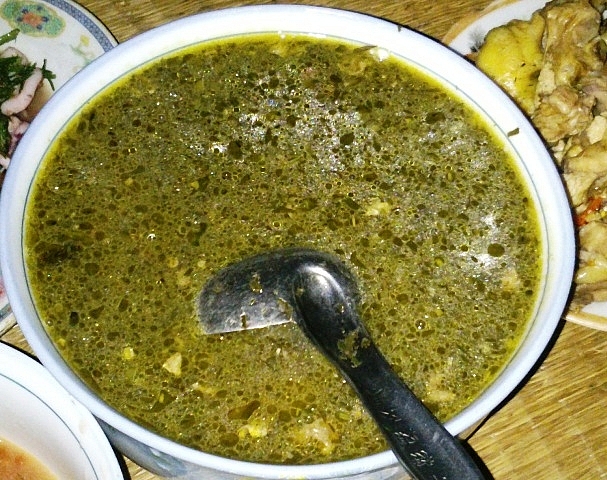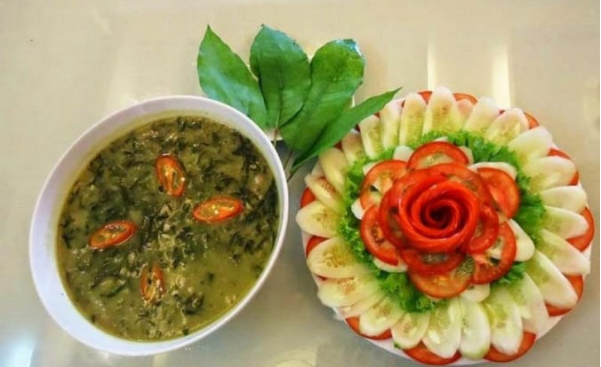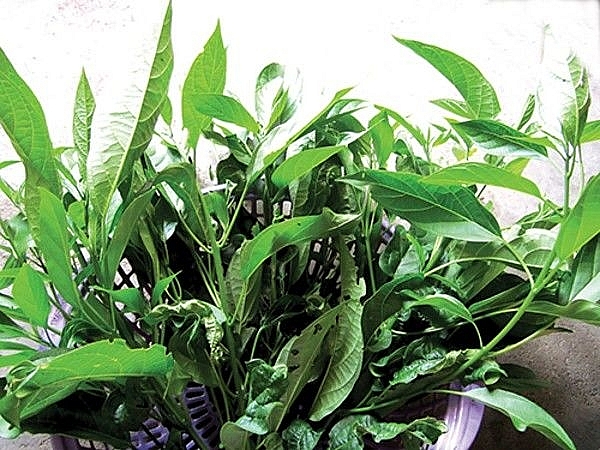 |
| Bitter leaf blood soup |
In Lai Chau, there is a specialty, which is bitter leaf blood soup. Must enjoy this dish, visitors can feel the unique features of the culinary art of this land. In the past, when the dish of bitter leaf blood soup was not popular, to find it
It is not easy to make bitter leaves to make soup, because this plant only grows on the edge of forests and streams. Usually, only when there are distinguished guests, the host will go to the forest to find leaves to cook soup as an expression of intimacy and hospitality. Now, people in this area have brought trees to plant in their home gardens, on the fields, on the fields, visitors can buy leaves on every occasion of the market.
 |
The ingredients and how to cook bitter leaf soup are also very simple. Just a few minced pork lungs, a piece of blood and a few herbs along with a handful of bitter leaves (maybe fresh or dried) crushed, then boil water for all the ingredients and cook thoroughly. guests had a delicious bowl of bitter leaf soup to enjoy.
If anyone tastes this soup for the first time, it will be difficult to eat because of the bitter, acrid taste of the tongue, but it is the bitter taste that awakens the taste buds, making the meal more appetizing. Continue to enjoy, bitter leaf soup brings back sweet, fleshy, strangely fragrant.
 |
| Bitter leaf plant is the main ingredient of bitter leaf blood soup |
Not only a delicious dish, bitter leaf soup also has the effect of treating diarrhea, alcohol, and human pain, so it is used by the highland ethnic people. In meals, festivals, filial piety, bitter leaf soup is often an appetizer.
Bitter leaf soup will be more delicious when diners eat in cold weather, drink a cup of H’mong millet wine, then visitors will really enjoy the sweet, fleshy, spicy and bitter taste of the soup. If ever coming to the Northwest region, visitors should look to the salad with coriander leaves and a bowl of bitter leaf soup to feel the unique features of the culinary art of this land.
Source: Collected internet.
Vietnam is the homeland of diverse bloodlines. The community of 54 ethnic groups is divided into hundreds of smaller groups. Each ethnic minority maintains its own culture, with its own rituals, costumes, and language. The best way to learn about them is through practical experiences such as living with indigenous people, or learning how to weave fabric with unique patterns. National culture is always an attractive highlight of Vietnamese tourism.
The specialties of each region of Vietnam carry within themselves the local lifestyle and the quintessence of nature there. The North cherishes delicate recipes, like a delicious bowl of bun thang that must be prepared for many hours. In the Central region, royal culinary traditions and typical spices blend in unique dishes such as lotus rice or spring rolls. Southern braised fish and sour soup come from abundant seafood resources, the pride of the Mekong Delta.
Vietnam's costumes are very diverse and rich, but the ones that impress people the most are the ao dai and the four-piece dress. The outfit carries the look and soul of Vietnam and when it comes to it, people will immediately think of Vietnam and that is the traditional ao dai. Traditional ao dai consists of a long shirt split into two front and back flaps, floor-length pants, material is silk or plain fabric, diverse colors and patterns.
Located on the banks of Ka Long, the border river between Vietnam and China, Xa Tac Temple, Mong Cai City, Quang Ninh Province, is not only a place to worship and practice folk cultural beliefs of residents. This place also has significance as a cultural milestone, affirming the sacred sovereignty of the Fatherland. Recently, this hundreds of years old historical and cultural relic was recognized by the Ministry of Culture, Sports and Tourism as a National relic because of its unique values....